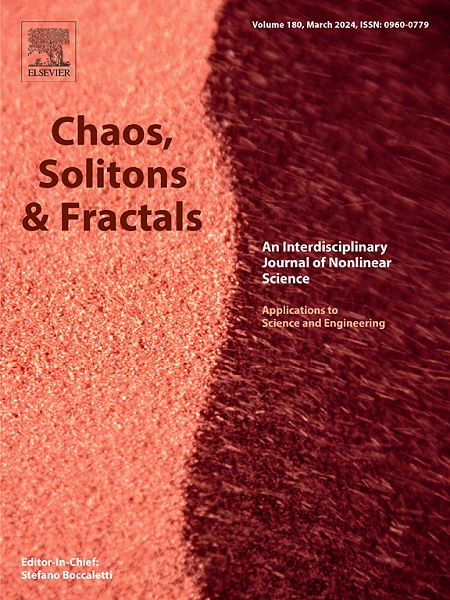Modified Adomian decomposition mechanism for hybrid nanofluid flow through rocket engine nozzle based CoFe2O4 and Ag nanoparticles
IF 5.6
1区 数学
Q1 MATHEMATICS, INTERDISCIPLINARY APPLICATIONS
引用次数: 0
Abstract
The principal aim of the contemporary investigation is to examine the influences of a hybridized nanofluid using Cobalt ferrite and silver gold nanoparticles in a nozzle of rocket engine. Moreover, the contribution of the dissipative heat alongside the impact of thermal radiation energises the heat transport phenomenon. It has diverse industrialized implementations involving aeronautical engineering and the modeling of polymerized melts. In the context of mathematical modeling, using the correspondence alteration method (similarity transformation), the leading equations were renewed into a system of nonlinear ODEs. This issue is handled semi-analytically by utilizing the Modified Adomian Decomposition Method (MADM) in the MATLAB program to study the influence of relevant physical factors. The temperature and velocity profile graphs for important quantities are shown, as well as the logical and physical reasoning behind them. Verification is also performed to confirm the executed experiments. The results show Reynolds number clearly affects the flow speed of the nanofluid, as the speed declines immediate the side layer or the surface of the missile containing the nanofluid. A large heat flow, which upsurges the temperature and expands the boundary layer, is caused by an increment in the radiation parameter and Eckert number. The viscosity of nanoparticles increases, and the effect is more extensive if both nanoparticles volume fraction increases. The effect of cobalt ferrite nanoparticles is more noticeable than the consequence of silver nanomolecules on the relative heat capacity of the nanofluid. The surface friction of the hybridized nanofluid flow declines with the potential parameters studied. Rising the Eckert number reduces the heat transfer ranks of the nano-fuel.

基于CoFe2O4和Ag纳米颗粒的火箭发动机喷嘴混合纳米流体流动的改进Adomian分解机理
当前研究的主要目的是研究使用钴铁氧体和银金纳米颗粒混合的纳米流体在火箭发动机喷嘴中的影响。此外,耗散热量的贡献以及热辐射的影响为热传输现象提供了能量。它有不同的工业化实施,涉及航空工程和聚合熔体的建模。在数学建模的背景下,利用对应变换方法(相似变换)将前导方程更新为非线性ode系统。利用MATLAB程序中的修正Adomian分解法(MADM)对该问题进行半解析处理,研究相关物理因素的影响。显示了重要量的温度和速度分布图,以及它们背后的逻辑和物理推理。还进行了验证,以确认已执行的实验。结果表明,雷诺数对纳米流体的流动速度有明显的影响,在含有纳米流体的导弹的侧层或表面,速度会立即下降。由于辐射参数和埃克特数的增加,产生了较大的热流,使边界层的温度升高并膨胀。纳米颗粒的黏度增大,且两种纳米颗粒体积分数增大,其影响更为广泛。钴铁氧体纳米颗粒对纳米流体相对热容的影响比银纳米颗粒对纳米流体相对热容的影响更为显著。混合纳米流体的表面摩擦随电位参数的变化而减小。埃克特数的增加降低了纳米燃料的传热等级。
本文章由计算机程序翻译,如有差异,请以英文原文为准。
求助全文
约1分钟内获得全文
求助全文
来源期刊

Chaos Solitons & Fractals
物理-数学跨学科应用
CiteScore
13.20
自引率
10.30%
发文量
1087
审稿时长
9 months
期刊介绍:
Chaos, Solitons & Fractals strives to establish itself as a premier journal in the interdisciplinary realm of Nonlinear Science, Non-equilibrium, and Complex Phenomena. It welcomes submissions covering a broad spectrum of topics within this field, including dynamics, non-equilibrium processes in physics, chemistry, and geophysics, complex matter and networks, mathematical models, computational biology, applications to quantum and mesoscopic phenomena, fluctuations and random processes, self-organization, and social phenomena.
 求助内容:
求助内容: 应助结果提醒方式:
应助结果提醒方式:


